![]()
![]()
![]()
Use LEFT and RIGHT arrow keys to navigate between flashcards;
Use UP and DOWN arrow keys to flip the card;
H to show hint;
A reads text to speech;
92 Cards in this Set
- Front
- Back
|
thallus
|
plant body of bryophytes
|
|
|
rhizoid
|
rootlike structures in bryophytes
|
|
|
gametophyte
|
in plants, the haploid (n), gamete-producing generation , which alternates with the diploid (2n) sporophyte.
|
|
|
antheridium
|
a sperm-producing organ
|
|
|
archegonium
|
the multicellular egg-producing organ in bryophytes and some vascular plants
|
|
|
sporophyte
|
the spore-producing, diploid (2n) phase in the life cycle of a plant having alternation of generations
|
|
|
sporangium
|
a structure in which spores are produced
|
|
|
capsule
|
what moss sporophytes consist of, located atop the seta, covered by the calyptra, inside are numerous haploid spores formed by meiosis
|
|
|
seta
|
stalks of moss sporophytes, extend upward from the moss gametophyte
|
|
|
calyptra
|
the upper portion of the archegonium that covers the apex of the capsule
|
|
|
blade
|
the broad, expanded part of a leaf, also called the lamina
|
|
|
rhizome
|
in vascular plants, a more or less horizontal underground stem, may be enlarged for storage or may function in vegetative reproduction
|
|
|
homosporous
|
in some plants, production of only one type of spore rather than differential types
|
|
|
microphyll
|
in plants (club mosses), a leaf that has only one vein connecting it to the vascular cylinder of the stem
|
|
|
megaphyll
|
in plants, a leaf that has several to many veins connecting it to the vascular cylinder of the stem, most plants have these
|
|
|
heterosporous
|
in vascular plants, having spores of two kinds, namely, microspores and megaspores
|
|
|
nucellus
|
tissue composing the chief pair of young ovules, in which the embryo sac develops; equivalent to a megasporangium
|
|
|
pollination
|
the transfer of pollen from an anther to a stigma
|
|
|
fertilization
|
the fusion of two haploid gamete nuclei to form a diploid zygote nucleus
|
|
|
megasporophyll
|
leaflike structure of the sporophyte generation that bear megaspores
|
|
|
microsporophyll
|
leaflike structure of the sporophyte generation that bear microspores
|
|
|
sporophyll
|
leaflike structures of the sporophyte generation that bear spores
|
|
|
sorus
|
a group of sporangia that form on the underside of fern fronds
|
|
|
frond
|
a mature fern leaf
|
|
|
protonema
|
is a thread-like chain of cells that forms the earliest stage (the haploid phase) of a bryophyte life cycle, develops into a leafy gametophyte
|
|
|
pinna
|
are the divisions of a compound frond, analogous to the leaflets of a compound leaf
|
|
|
megaspore
|
a haploid reproductive cell, usually unicellular, capable of developing into the archegonium without fusion with another cell
|
|
|
microspore
|
a haploid reproductive cell, usually unicellular, capable of developing into the antheridium without fusion with another cell
|
|
|
megasporangia
|
form on megasporophylls, where megaspores are produced by meiosis
|
|
|
microsporangia
|
form on microsporophylls, where microspores are produced by meiosis
|
|
|
megagametophyte
|
in plants, the haploid (n), megagamete-producing, which alternates wit hthe diploid (2n) megasporophyte
|
|
|
microgametophyte
|
in plants, the haploid (n), microgamete-producing, which alternates wit hthe diploid (2n) microsporophyte, aka pollen grains
|
|
|
annulus
|
the ring-like row of cells surrounding the sorus of ferns and responsible for opening it when ripe
|
|
|
stem
|
the above ground structure that have vascular tissue and that support leaves and flowers
|
|
|
stalk
|
a plant stem
|
|
|
prothallium
|
spore-bearing plant, (almost exclusively ferns) in gametophyte stage in the alternation of generations cycle
|
|
|
strobilus
|
is an organ of many plants that contains the reproductive structures, characterized by a central axis (anatomically a stem) surrounded by spirally arranged or decussate structures that bear sporangia or other reproductive parts
|
|
|
pollen
|
is a fine to coarse powder containing the microgametophytes of seed plants, which produce the male gametes (sperm cells)
|
|
|
seed
|
is a small embryonic plant enclosed in a covering, the product of the ripened ovule of gymnosperm and angiosperm plants which occurs after fertilization and some growth within the mother plant
|
|
|
integument
|
the tissue that surrounds the nucellus
|
|
|
Phylum: Bryophyta
-common name -notes |
common name: mosses
notes: thallus; homosporous |
|
|
Phylum: Lycophyta
-common name -notes |
common name: club mosses
notes:microphylls; homo- & heterosporous |
|
|
Phylum: Pterophyta
-common name -notes |
common name: ferns
notes: megaphylls; homo- & heterosporous |
|
|
Phylum: Sphenophyta
-common name -notes |
common name: horsetails or scouring rushes
notes: magaphylls; homosporous |
|
|
parts of the pine leaf
|
stoma, guard cell, cuticle, epidermis, resin duct, photosynthetic tissue, endodermis and vascular tissue
|
|
|
another name for the male cone of gymnosperms
|
staminate cone
|
|
|
another name for the female cone of gymnosperms
|
ovulate cone
|
|
|
parts of the male (staminate) cone
|
microsporophyll, microsporangium and pollen grains (aka microgametophyte)
|
|
|
parts of the female (ovulate) cone
|
megasporophyll, nucellus, integument, megagametophyte, ovum, archegonium and micropyle
|
|
|
micropyle
|
the opening at the apex of the integument
|
|
|
Distinguish between vascular and nonvascular plants.
|
vascular plants include the ferns, clubmosses, flowering plants, conifers and other gymnosperms, consist of a root system and a shoot system, are those plants that have lignified tissues for conducting water, minerals, and photosynthetic products through the plant, have vascular tissues, which circulate resources through the plant. This feature allows vascular plants to evolve to a larger size than non-vascular plants, which lack these specialized conducting tissues and are therefore restricted to relatively small sizes
|
|
|
Distinguish between nonseed and seed plants.
|
seed plants: heterosporous plants (plants that produce two types of spores--that develop into haploid male and female gametophytes); produce seeds
|
|
|
parts of the moss mature capsule
|
sporangia, spores, calyptra, & operculum
|
|
|
parts of the Polytrichum antheridial head
|
anteridium and sperm
|
|
|
parts of the moss archegonium
|
archegonium, venter, neck and ovum (egg)
|
|
|
parts of the moss protonema
|
inmature gametophyte (bud, rhizoid)
|
|
|
parts of the Lycopodium mature strobilus
|
microphylls, sporophylls, sporangia, spores
|
|
|
part of the Equisetum mature strobilus
|
megaphylls, sporophylls, sporangia, and spores
|
|
|
part of the Polypodium sorus
|
megaphyll, sporophylls, sporangia, annulus, and spores
|
|
|
parts of the fern antheridia & archegonia
|
prothallium, rhizoids, antheridia, & archegonia
|
|
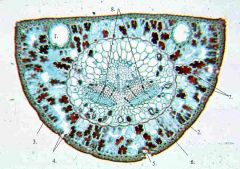
Identify parts
Name and phyla |
Pine Leaf
Phyla: Coniferophyta 1. resin duct 2. cuticle 3. epidermis 4. guard cell 5. stoma 6. endodermis 7. photosynethetic tissue 8. vascular tissue |
|
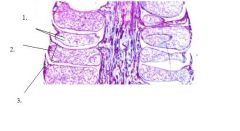
Identify
Name and Phyla |
Male (staminate) cone
Coniferophyta 1. Microsporophyll 2. Microsporangium 3. Pollen grains aka microgametophytes (from microspores) |
|
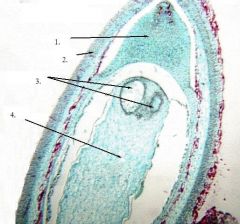
Identify.
Name and Phyla |
female (ovulate) cone
Phyla: Coniferophyta 1. Nucellus 2. Integument 3. Archegonia 4. Megagametophyte Not shown: Megasporophyll, Micropyle, Ovum |
|
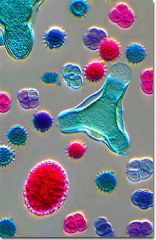
Identify the pine pollen amongst the pollen from flowering plants.
Phyla its associated with |
blue on bottom next to the purple in the lower right-hand corner
Coniferophyta |
|
|
ovuliferous scales
|
wooden scales on female cone: any one of the wooden scales of a female cone of a coniferous plant, e.g. a pine, that bears ovules and hence seeds
|
|
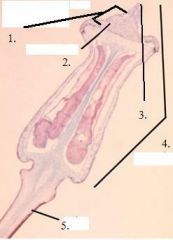
Identify:
Parts Name Phyla |
Name: moss mature capsule
Phyla: Bryophyta 1. sporangia 2. spores 3. operculum 4. capsule 5. set not shown/labeled: calyptra |
|
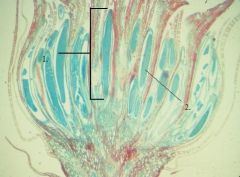
Identify:
Name Phyla Parts |
Polytrichum antheridial head
Bryophyta 1. antheridium 2. (dots) sperm |
|
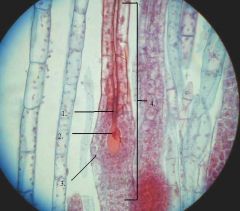
Identify
Name Phyla Parts |
Moss archegonium
Bryophyta 1. neck 2. ovum (egg) 3. venter 4. archegonium |
|
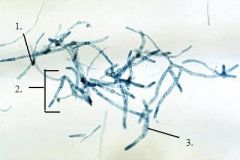
Identify:
Name Phlya Parts |
Moss protonema
Bryophyta 1. bud 2. inmature gametophyte (germinating spores) 3. rhizoid |
|
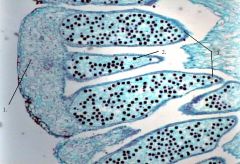
Identify
Name Phyla Parts |
Equisetum mature strobilus
Sphenophyta 1. sporophylla 2. spores 3. sporangia not labeled: megaphylls |
|
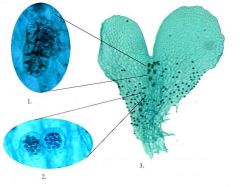
Identify:
Name Phyla Parts |
Fern antheridia and archegonia
Pterophyta 1. archegonia 2. antheridia 3. prothallium not labeled: rhizoids |
|
|
Draw the generalizes plant life cycle.
|
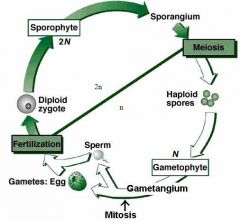
not shown in pictures:
-after the sporangia, but before meiosis 2n Spore mother cell -the mutiple spores turn into one spore the into the gametophyte -zygote goes to embryo then to sporophyte |
|
|
Describe the common characteristics of the plant kingdom
|
with few exceptions, plants are autotrophic, contain chlorophyll a, and have cell walls containing cellulose. Life cycles of all members of the plant kingdom are variations on alternation of generations
|
|
|
the major groups of plants
|
bryophytes (mosses, liverworts, and hornworts)
ferns and fern allies gymnosperms angiosperms |
|
|
How are the major groups of plants distinguished?
|
these groups of plants are distinguished by morphology, life cycle, and the presence or absence of vascular tissue
|
|
|
List Phylas of the Plant Kingdom in order from the most primitive to the least
|
1. Bryophyta
2. Lycophyta 3. Sphenophyta 4. Pterophyta 5. Gymnosperms/ Coniferophyta |
|
|
What Phylas fits the following describtion:
no vascular tissue no seeds |
Bryophyta
|
|
|
What Phylas fits the following describtion:
vascular tissue no seeds |
Lycophyta
Sphenophyta Pterophyta |
|
|
What Phylas fits the following describtion:
vascular tisse have seeds |
Gymnosperm
|
|
|
How is the life cycle of bryophytes characterized?
|
have both gametophyte and sporophyte phases, gametophyte is the dominant phase
have mutlicellular sex organs ANTHERIDIA=male sex organs that produce swimming, biflaggelate sperm **require free water for sexual reproduction bc their sperm must swim to the egg** ARCHEGONIA=female sex organ that produce the eggs ZYGOTE=the fertilized egg zygote divides and matues in the archegonium to produce the SPOROPHYTE, which remains attached to and nutritionally dependent on the GAMETOPHYTE the mature sporophyte produces haploid spores (via meiosis), each of which can develope into a gametophyte |
|
|
Compare liverworts and mosses
|
Mosses are often more visible than liverworts because of their greater numbers, more widespread distribution, and bc gametophyte plants of mosses are leafy and usually stand upright.
mosses withstand desiccation better than liverworts mosses often grow in a greater diversity of habitats moss gametophyte is radically symmetrical and is the most conspicious phase of the moss life cycle ther are both dioecious |
|
|
How do mosses produce asexualy?
|
through fragmentation
|
|
|
Phyla Lycophyta
Examples Key Characteristics |
Example: club mosses
Key Characteristics: -homo or heterosporous -vascualr -sperm motile -external water necessary for fertilization -leaves are microphylls |
|
|
Phyla Sphenophyta
Examples Key Characteristics |
Examples: horsetails or scouring rushes
Key Characteristics: -homosporous -vascular -sperm motile -external water necessary for fertilization -stems ribbed, jointed, either photosynthetic or non- -leaves scale-like, in whorls, nonphoto at maturity |
|
|
Phyla Pterophyta
Examples Key Characteristics |
Examples: ferns
Key Characteristics: -primarily homosporous -vascular -sperm motile -external water necessary for fertilization -leaves are megaphylls, that uncoil as they mature -sporophytes and virtually all gametophytes photosynthetic |
|
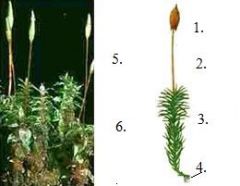
Identify
Parts Name Phyla |
Name: mature moss sporophyte
Phyhla: Bryophyta 1. capsule 2. seta 3. stem and leaves 4. rhizoids 5. sporophyte stage 6. gametophyte phase |
|
|
Describe the life cycle of seedless vascular plants.
|
they include both gametophyte and sporophyte phases, sporophyte is the dominant phase
|
|
|
Describe the distinctive/unique characteristics and structures of the Phyla Pterophyte.
|
SPOROPHYLLS are leaflike structures of the sporophyte generation that bears spores
have large MEGAPHYLLS with several to many veins or they may be smaller MICROPHYLLS with one vien SPORANGIA which form on sporophylls, are where spores are produced by meiosis form on the backs of leaves hence why sporophylls are called sprophylls require water for fertilization sporophytes grow indefintely via underground stgems called RHIZOMES groups of sporangia called SORI form on the underside of fern fronds meiosis in the sporangium produces haploid spores, the first stage of the gametophyte fern spores germinate and form a threadlike PROTENMA subsequent cellular divisions produce an independent heart -shaped PROTHALLIUM antheridia (globe-shaped, forms first) and archegonia (vase-shaped, located at the cleft of the prothallium) mature at different times after producing sperm, antheridia drop off leaving the sperm to swim to he archegonia of the other prothallia zygote developes in the archegonium, soon after the sporophyte becomes leaflike and crushes the prothallium fronds of the growing sporophyte breal through the soil in a coiled position called FIDDLEHEAD, which unrolls to form the frond a single leaf **since homosporous they produce one kind of spore that develops into a single kind of gametophyte that produces both antheridia and archegonia** |
|
|
Compare ferns to bryophytes
|
ferns have well-developed vascular tissue
unlike bryophytes, ferns have an independent sporophyte and stomata |
|
|
Describe the distinctive/unique characteristics and structures of the Phyla Sphenophyta
|
strobili occur at the tips of reproductive stems
sporangia form atop umbrellalike modified braches called SPORANGIOSPHORES elaters in the sporangia help disperse spores |
|
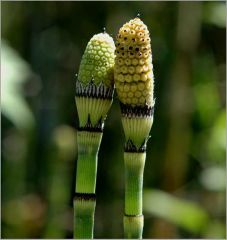
Identify
Name Phyla Parts |
Equisetum (sp) mature stobilus
Sphenophyta stobili are shown |
|
|
Describe the life cyle of the Phyla Lycophyta include distinctive/unique characteristics/structures
|
Sporangia of the Lycophyta occur on small modified leaves called SPOROPHYLLS cluster in STROBILI (cones) that form at the tips of the branches
most asexual reproduction occurs via rhizomes |

